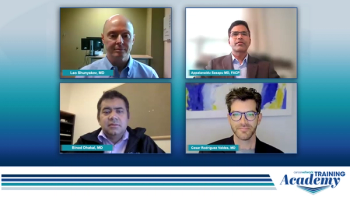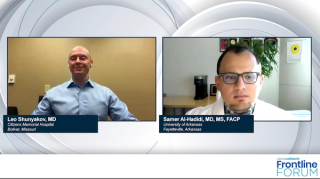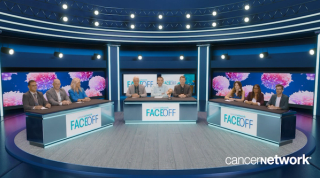
Multiple Myeloma
Latest News
Latest Videos
CME Content
More News

Panelists discuss how community practices establish protocols and processes for ongoing monitoring and management of potential long-term complications or adverse events from bispecific therapy.

Inside the Academic Approach: How Initial Consultations for Bispecific Therapy Referrals Are Handled
Panelists discuss how academic centers approach the initial consultation and evaluation process for patients referred for bispecific therapy from community practices.

Panelists discuss how transitioning patients with multiple myeloma from community to academic settings faces challenges including communication gaps, differences in treatment approaches, patient reluctance, and logistical hurdles.

Panelists discuss how community practices implement protocols and processes to monitor and manage potential long-term complications or adverse events associated with bispecific therapy, focusing on patient follow-up, adverse event reporting, and ongoing risk assessment.

Panelists discuss how patient-specific factors such as disease status, overall health, support systems, and treatment history are crucial considerations when determining readiness for potential transition to community settings for ongoing care.

Panelists discuss how cytokine release syndrome and neurological toxicities have been the most challenging adverse events to manage with GPRC5D-targeted therapies, requiring proactive monitoring and intervention strategies, while noting that these side effects are generally similar to those seen with other bispecifics.

Panelists discuss how cytokine release syndrome and neurological toxicities have been the most prevalent safety concerns in community settings when using bispecific therapies, requiring careful monitoring and management strategies.

Following the review of a case of a patient with relapsed/refractory multiple myeloma, the panel provides expert perspectives on adverse event management practices.

Panelists discuss how the initial process of identifying and referring potential candidates for bispecific therapy from the community setting to an academic center involves careful patient assessment, clear communication channels, and established referral protocols to ensure timely and appropriate treatment initiation.

Samantha Shenoy, NP, MSN, discusses how her role plays a vital part in patient care for those receiving talquetamab for multiple myeloma.

P-BCMA-ALLO1 yielded lymphodepletion responses even among those with prior exposure to other CAR T-cell therapies or bispecific agents.

Panelists discuss how GPRC5D-targeted bispecifics are likely to be incorporated earlier in treatment sequencing for multiple myeloma in the future, while considering factors such as optimal timing, potential combinations with other therapies, sequencing strategies, and possible drug interactions when integrating these treatments into the overall management of relapsed/refractory multiple myeloma patients.

Panelists discuss how multiple myeloma care faces challenges including patient reluctance to seek treatment at academic centers, complex treatment landscapes, and the need for improved coordination between community and academic physicians.

Experts on multiple myeloma address the intricacies of adverse event management practices, focusing on taste changes and associated weight loss.

Panelists discuss how specific biomarkers, such as GPRC5D expression levels, and clinical features, influence their decision to initiate GPRC5D bispecific therapies in multiple myeloma patients.

Samantha Shenoy, NP, MSN, presents the case of a patient with multiple myeloma and the panel discusses adverse event management practices.

Panelists discuss how collaborative care settings for multiple myeloma patients often lead to improved outcomes compared to non-collaborative approaches, citing factors such as access to specialized expertise, coordinated treatment plans, and comprehensive patient support.

Data support the addition of daratumumab to standard lenalidomide maintenance in patients with newly diagnosed multiple myeloma following transplant.

Treatment with durcabtagene autoleucel meets the primary end point of a phase 2 study in relapsed/refractory multiple myeloma.

Data from a phase 1b/2 trial show that sonrotoclax/dexamethasone appears to be well tolerated in a heavily pretreated multiple myeloma population.

Thomas G. Martin, MD, discussed the advantages of quadruplet therapy for multiple myeloma in light of an FDA approval for Isa-VRd in this indication.

Panelists discuss how streamlining the referral process for multiple myeloma patients can significantly reduce treatment initiation.

Panelists discuss how effective collaboration, care coordination, and communication between academic and community physicians are crucial for ensuring seamless transitions and high-quality care for patients with multiple myeloma.

The panel provides an overview of REMS programs for bispecific therapies in multiple myeloma and discusses how institutions can educate healthcare professionals outside of oncology.

Experts on multiple myeloma discuss prophylactic supportive measures to prevent CRS and ICANS in patients who receive GPRC5D therapy.























































































